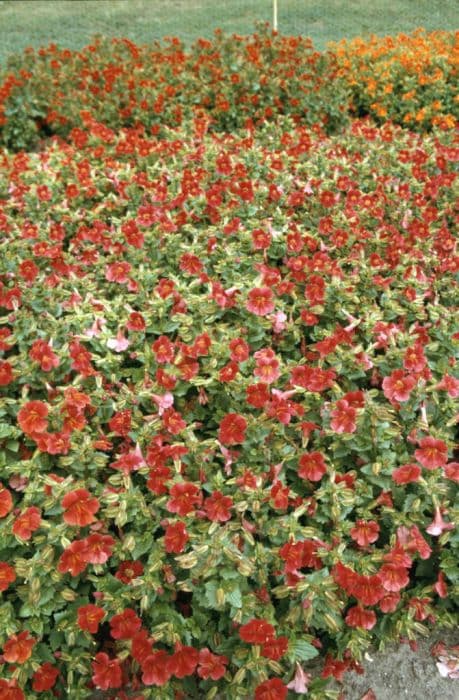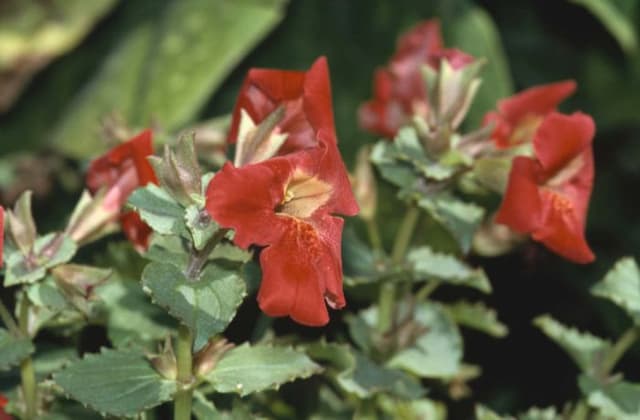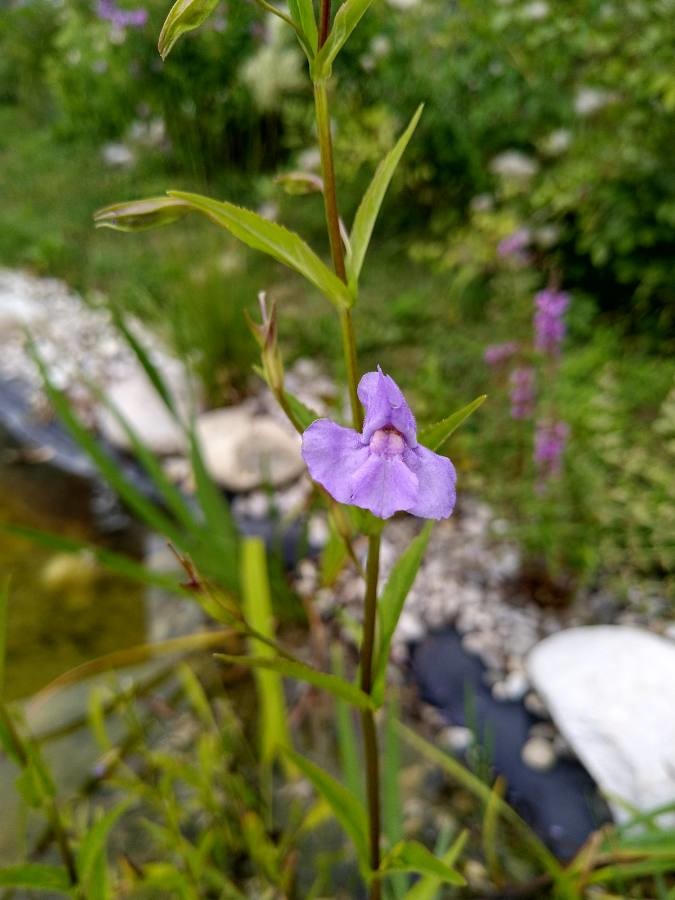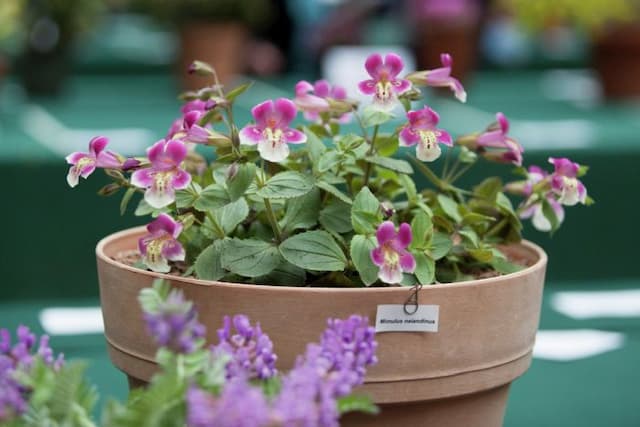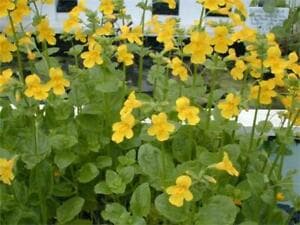Monkey Flower Mimulus primuloides

ABOUT
Mimulus primuloides, commonly known as primrose monkeyflower, is a visually charming perennial plant notable for its lush foliage and appealing flowers. Its leaves are generally bright green, with a rounded to oval shape and a slightly toothed margin, forming a low-growing rosette. This plant is characterized by its abundant, vibrant blooms that come in various shades of yellow, often with intricate patterns or spots in a deeper or reddish-yellow tone. The flowers typically have a tubular base that flares out into five distinct lobes, giving them a resemblance to a monkey's face, which is where the common name "monkeyflower" originates. The overall appearance of primrose monkeyflower is of a dense, mat-forming plant that displays a profusion of cheerful flowers.
About this plant
 Names
NamesSynonyms
Primula Monkeyflower, Primrose Monkey Flower, Yellow Monkeyflower
Common names
Diplacus primuloides, Eunanus primuloides, Mimulus glabratus var. primuloides.
 Toxicity
ToxicityTo humans
Mimulus primuloides, commonly known as primrose monkeyflower, is not widely reported to be toxic to humans. There is limited information on its potential toxicity, as it is primarily grown for ornamental purposes and not typically ingested. As with many plants, it is always wise to exercise caution and avoid consumption unless it has been deemed safe by a knowledgeable authority. If you suspect poisoning from any plant, seek medical attention promptly.
To pets
Primrose monkeyflower is not commonly listed as toxic to pets. However, as with humans, there is little information on the plant's toxicity to animals because it is neither commonly ingested by pets nor studied for this purpose. While it might not be poisonous, it is still recommended to prevent pets from ingesting this plant. If your pet consumes any part of the plant and shows signs of distress, consult with a veterinarian.
 Characteristics
CharacteristicsLife cycle
Perennials
Foliage type
Deciduous
Color of leaves
Green
Flower color
Yellow
Height
0.3 feet (10 cm)
Spread
0.5 feet (15 cm)
Plant type
Herb
Hardiness zones
5
Native area
North America
Benefits
 General Benefits
General Benefits- Erosion Control: Mimulus primuloides has a root system that helps stabilize soil and prevent erosion, particularly useful in sloped garden areas or along streambanks.
- Habitat Support: It provides nectar and habitat for a variety of pollinators including bees, butterflies, and hummingbirds, contributing to local biodiversity.
- Aesthetic Appeal: With its vibrant yellow flowers, the plant adds visual interest and color to gardens, especially in rockeries, alpine gardens, or as ground cover.
- Low Maintenance: The primrose monkeyflower is relatively easy to grow, requiring minimal care once established, making it suitable for low-maintenance landscaping.
- Drought Tolerance: Once established, it can tolerate periods of dryness, making it a good choice for water-conserving gardens or in regions with water restrictions.
- Versatility: It can be planted in a variety of soil types and garden conditions, from full sun to partial shade, providing great adaptability for different garden designs.
 Medical Properties
Medical PropertiesThis plant is not used for medical purposes.
 Air-purifying Qualities
Air-purifying QualitiesThis plant is not specifically known for air purifying qualities.
 Other Uses
Other Uses- Mimulus primuloides, commonly known as monkeyflower, can be used for ornamental purposes in rock gardens or alpine garden settings due to its low-growing, mat-forming habit and vibrant yellow flowers.
- The dense foliage of monkeyflower may be used as a living mulch in garden beds to suppress weeds and maintain soil moisture.
- Monkeyflower has been cultivated for its potential use in phytoremediation, helpful in stabilizing soil and preventing erosion in disrupted ecosystems.
- The vibrant flowers of monkeyflower can act as a natural attractant for pollinators like bees, butterflies, and hummingbirds, promoting biodiversity in the garden.
- Monkeyflower can be used in educational settings to teach botany and ecology, particularly about plant adaptation in wetland or riparian environments.
- The plant is sometimes used by enthusiasts of water-wise gardening practices due to its ability to thrive in moist conditions without needing excessive water once established.
- Because monkeyflower can thrive in challenging growing conditions, it can be utilized in habitat restoration projects, particularly those focusing on riparian zones.
- Monkeyflower's visual appeal makes it a candidate for nature-inspired art projects, with its flowers often being used in pressed flower crafts or botanical prints.
- Children may use monkeyflower plants to learn about plant life cycles and pollination through simple, hands-on gardening projects.
- In creative culinary uses, the edible flowers of monkeyflower can occasionally be used as a colorful garnish on salads and desserts.
Interesting Facts
 Feng Shui
Feng ShuiThe Monkey Flower is not used in Feng Shui practice.
 Zodiac Sign Compitability
Zodiac Sign CompitabilityThe Monkey Flower is not used in astrology practice.
 Plant Symbolism
Plant Symbolism- Overcoming Fear: Mimulus, often known as Monkeyflower, generally symbolizes overcoming fears and phobias as they are thought to help individuals confront their challenges with courage.
- Emotional Expressiveness: Monkeyflower is believed to encourage the expression of hidden emotions, promoting honesty in one's feelings and communication.
- Protection: In some traditions, Monkeyflower is considered a plant of protection, offering a shield against negative energies and providing a sense of safety.
- Playfulness: With its bright and often whimsical appearance, Monkeyflower can represent playfulness and a reminder to enjoy the lighter side of life.
- Healing: Known for its therapeutic properties in flower essence therapy, Monkeyflower is associated with the healing of emotional wounds and facilitating inner peace.
 Water
WaterMonkey flower (Mimulus primuloides) prefers consistently moist soil, so it's important to water it when the top inch of soil feels dry. Aim to water this plant deeply, about once or twice a week, providing approximately half a gallon per square foot of soil each time during the growing season. Cut back on watering in the cooler months to prevent waterlogging, decreasing to perhaps a quarter gallon per square foot every other week, depending on the humidity and temperature. Always check the soil moisture before watering to avoid overwatering.
 Light
LightMonkey flower thrives in bright, indirect light, making it suitable for a spot that receives filtered sunlight or dappled shade. Avoid placing it in direct, harsh sunlight as it can scorch the delicate foliage. An east or north-facing window would be an ideal spot indoors, while outdoor plants prefer a location that mimics their natural woodland habitat, under the partial shade of larger plants or trees.
 Temperature
TemperatureMonkey flower prefers a temperate to cool environment, with ideal temperatures ranging from 60 to 75 degrees Fahrenheit. It can survive minimum temperatures of about 50 degrees Fahrenheit and should be protected from frost. Avoid exposing the plant to temperatures over 80 degrees Fahrenheit, as excessive heat can stress the plant and affect its growth and flowering.
 Pruning
PruningPruning monkey flower is essential for encouraging bushy growth and may promote more blooms. Trim the plant back in early spring or after the main flowering period to shape the plant and remove any dead or diseased stems. Pruning can be done every few months during the growing season to maintain the desired size and shape.
 Cleaning
CleaningAs needed
 Soil
SoilFor Mimulus primuloides, commonly known as primrose monkeyflower, the best soil mix is a well-draining mix with added organic matter like peat or compost. It prefers moist conditions but does not tolerate soggy soil. A slightly acidic to neutral pH of 6.0-7.0 is ideal for this plant.
 Repotting
RepottingThe primrose monkeyflower should be repotted biennially or when it outgrows its current pot, which is typically every 2-3 years. It's best to repot in the spring to allow the plant to establish in the growing season.
 Humidity & Misting
Humidity & MistingPrimrose monkeyflower thrives in moderate to high humidity levels. The best range is between 50-70% relative humidity, which mimics its natural damp habitat.
 Suitable locations
Suitable locationsIndoor
Ensure bright light, moist soil, and high humidity for indoor primrose monkeyflower.
Outdoor
Plant in a damp, shaded area with rich, well-draining soil for outdoor primrose monkeyflower.
Hardiness zone
5-9 USDA
 Life cycle
Life cycleMimulus primuloides, commonly known as primrose monkeyflower, begins its life cycle as a seed, typically germinating in moist, well-drained soils in spring. After germination, the seedling emerges and develops a rosette of oval-shaped leaves as it enters the vegetative growth stage. During this stage, the plant focuses on photosynthesis and root development to establish itself. As it matures, the primrose monkeyflower enters the flowering stage in late spring to summer, producing bright yellow flowers that attract pollinators for reproduction. After pollination, the flowers develop into fruits which contain seeds, completing the cycle when these seeds are dispersed, often by water or animals. In autumn, the above-ground parts of the plant die back, with the plant overwintering as rootstock or dormant seed until the next favorable growing season.
 Propogation
PropogationPropogation time
Spring to Summer
Propogation: Mimulus primuloides, commonly known as Primrose Monkeyflower, is a plant species that is best propagated through seed sowing. The ideal time to sow seeds is late winter to early spring when the threat of frost has passed. To propagate by seeds, prepare a seed starting mix in a tray or pots and sprinkle the tiny seeds on the surface, lightly pressing them into the mix without covering them, as they need light to germinate. Keep the soil consistently moist but not waterlogged, and place the tray in a warm spot with indirect light. Germination usually occurs within 2 to 4 weeks at temperatures between 65 to 75 degrees Fahrenheit (18 to 24 degrees Celsius). Once seedlings emerge and develop their first true leaves, they can be carefully transplanted into individual pots to grow on before being moved outdoors after all danger of frost has passed.
